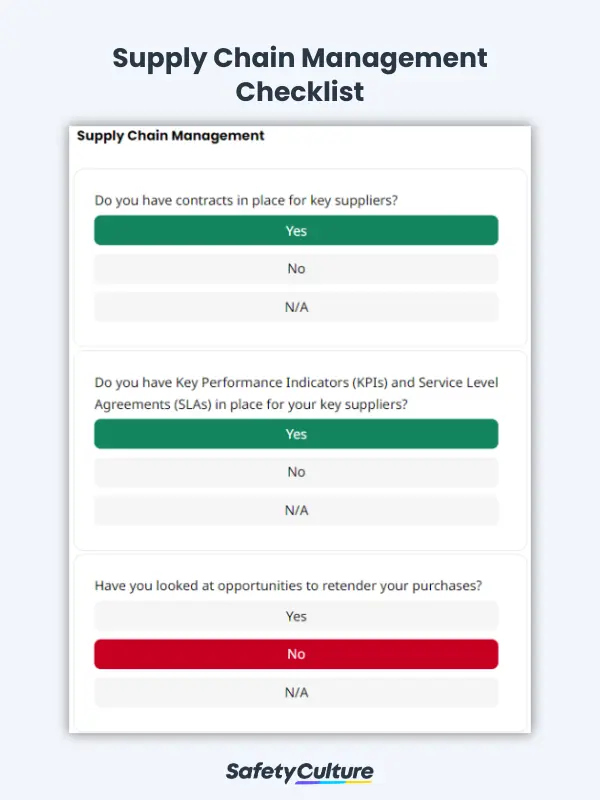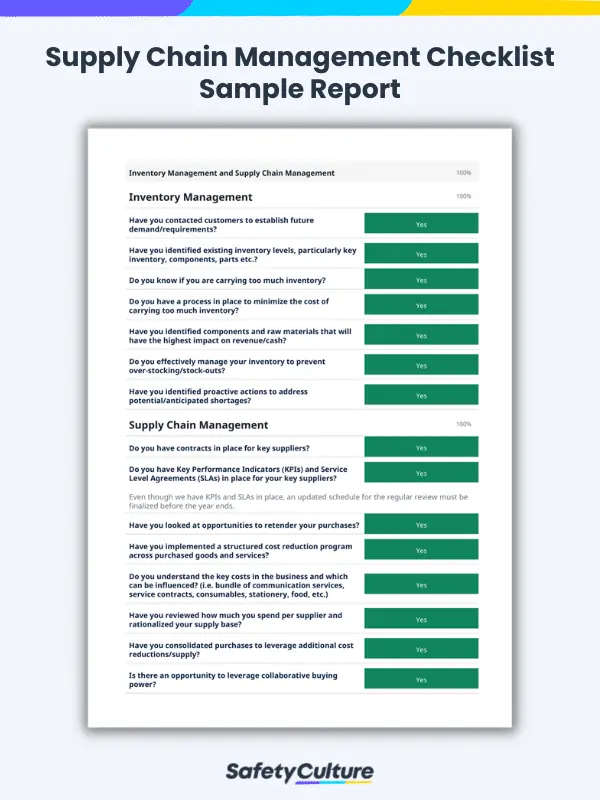What is a Supply Chain Management Checklist?
A supply chain management checklist is a tool used by organizations and entities that belong to the entire supply chain to ensure that every process involved is efficiently managed, successfully operational, and continuously improved. Supply chain managers, directors, and other key stakeholders use this checklist to make sure everything is accounted for so that manufacturing quality and worker safety are maintained.
Importance
A supply chain is a collaboration of multiple entities from different industries involved in processing raw materials into finished products and distributing them to the intended customers. Proper management of each entity in a supply chain is vital to maintain the uninterrupted, sustainable, and cost-effective production of goods and services.
In essence, supply chain management consists of four main parts:
- Demand Management – This involves the processes of demand planning, merchandise planning, and trade promotion planning.
- Supply Management – This pertains to the areas of supply planning, production planning, inventory planning, capacity planning, and distribution planning.
- Sales and Operations Planning (S&OP) – This comprehensive business management process typically involves the leadership and executives of an organization through strategizing and informed decision-making on key supply chain drivers.
- Product Portfolio Management – This process includes new product introductions, commercialization, and brand planning, among others.
How It Works
In most cases, supply chain management follows a 5-step process as coordinated and overseen by a supply chain manager:
- Planning – This phase involves ensuring that supply match with the demands both of the customers and the manufacturing process.
- Sourcing – Supplier relationships must be established as they play an important role in sourcing the raw materials and goods needed in the manufacturing process.
- Manufacturing – Using equipment, machinery, raw materials, and labor, manufacturers then produce goods. The overall manufacturing process entails sub-tasks to ensure quality and safety during production.
- Delivering – This is where the distribution phase comes in—the companies must now get the products to the customers.
- Returning – Part of the supply chain management process involves accommodating product and customer returns. This phase must help companies ensure that they can also issue refunds and address returns to avoid them in the future.
How to Minimize Supply Chain Risks in 3 Steps
A supply chain is only as strong as its weakest link and by identifying risks, and taking steps to minimize those risks, can one help strengthen the supply chain.
Step 1: The first step to minimize supply chain risks is to develop a comprehensive supply chain management checklist. Depending on the context of one’s position in the supply chain, the checklist can include items related to supplier audits, product testing, or inventory management.
Step 2: The next step in minimizing risks is to implement an effective supply chain audit software program. This program can help you track supplier performance and product quality.
Step 3: Finally, it’s important to conduct regular supply chain audits. This will help you identify and address any potential problems.
What to Include in a Supply Chain Management Checklist
While the needs of various businesses managing their supply chain may vary, the basics of a checklist that supply chain managers, directors, and other stakeholders involved must use should include the following sections and details:
- Title Page: This introduction should contain information about where and when the inspection, audit, or check was conducted, the company name, and who prepared or facilitated the inspection.
- Risk Management and Risk Mitigation: This section or page in your supply chain management checklist aims to help you ask and address questions about the risks that every entity in the business’s supply chain may face.
- Inventory Management and Supply Chain Management: This section or page must contain questions you should address to emphasize your organization’s efforts in ensuring stability in overall inventory and supply chain management.
- Completion: Reserve the last page of your checklist or report for any additional remarks and formal sign-off.
How to Perform a Supply Chain Audit?
A supply chain audit is a comprehensive check of all components of a business’s supply chain. Following the steps below when conducting supply chain audits can help ensure that all aspects of the supply chain are functioning properly and to catch any issues before they become costly problems.
- The first step is to gather all of the relevant information about your suppliers, the suppliers’ of your suppliers, and any other businesses involved in your supply chain.
- The next step is to verify the accuracy of the information that has been gathered. This includes verifying the contact information for suppliers, quantities and dates of shipments, among others.
- The third step is to assess the risks associated with the supply chain and every aspect of the overall supply chain management.
- The fourth step is to perform a physical inspection of your suppliers and their facilities. This includes inspecting the premises and the products themselves.
- The fifth step is product testing. This includes testing for product quality and to see if the products meet the required customer specifications. The sixth step is to interview the suppliers.
- The last step is to compile a report of the findings. This report should include a detailed description of the findings, along with recommendations for how any issues found can be resolved.
Browse and Download Free Supply Chain Management Checklists
In every aspect of the overall supply chain management, a lot of processes need to be efficiently accomplished and guidelines to be followed. Hence, having specific checklists and templates dedicated to every stakeholder in the supply chain is crucial to the success of the business.
Browse this collection of checklists and templates you can use to help you and your teams perform your tasks and have a more effective system of supply chain management.
Vendors

Vendors are the suppliers of parts and raw materials to be processed and assembled by manufacturers. Vendors need to consistently meet the expected quantity and quality of materials according to the specifications of manufacturers to maintain a good business relationship.
- IATF 16949:2016
- Supplier Audit
- Advanced Product Quality Planning (APQP)
- Vulnerability Assessment Critical Control Points (VACCP)
- Standard Operating Procedure (SOP)
Producers

Producers are the ones who process raw materials into finished products. Also called manufacturers, they need to operate in compliance with industry standards on quality and regulations on workplace safety. Producers are often required by business institutions to be certified for certain international standards before they can engage in business.
- Good Manufacturing Practices (GMP)
- ISO 9001 (Quality Management System)
- Hazard Assessment Critical Control Point (HACCP)
- Risk Assessment
- Layered Process Audit (LPA)
Warehouses

Warehouses store the finished products ready for distribution. Warehouses need to maintain the quality of products in storage and keep an organized and uninterrupted movement of goods while ensuring the safety of staff and forklift operators.
Distributors

Distributors transport the products from manufacturers to retailers or international markets with the help of third-party logistics companies or shippers. Distributors need to ensure that the quality of products does not degrade while in transit and that they arrive at the expected date and time.
- Heavy Vehicle Inspection
- Vehicle Inspection
- Vehicle Maintenance Log
- ISO Container Inspection
- Transport and Logistics
Retailers

Retailers make the finished products available for purchase to customers. Retailers need to ensure that there are enough products in stock and that they are displayed in a manner that is attractive to customers and aligned with product branding. Retailers need to maintain the cleanliness of retail outlets and empower staff in promoting a good customer experience to gain repeat customers.
FAQs About Supply Chain Management
Supply chain managers are commonly committed to handling the coordination, organization, and management of production, logistics, and distribution processes of a business’s products. Further, they work with other teams and departments to oversee product lifecycles.
While every organization sets its own specific goals for effective supply chain management, the most important ones include the following:
- Efficiency in fulfillment
- Streamlined logistics
- Improved quality
- Sustained customer value
- Supply chain resiliency and scalability
Since supply chain management involves a comprehensive system of activities and processes, it’s important for organizations to know and understand its different levels. In most cases, there are three:
- Strategic Planning
- Tactical Planning
- Operational Execution
The following are some questions that can be included on a checklist when performing a supply chain audit:
- Do you have a written supply chain management policy?
- Do you have a written procedure for receiving goods and materials?
- Are all goods and materials accurately received and documented?
- Is there a process in place to verify the accuracy of received goods and materials?
- Are goods and materials stored in an appropriate facility (e.g. climate controlled warehouse)?
- Is there a process in place for rotating stock?
- Are goods and materials transported in an appropriate manner?
- Are goods and materials delivered in a timely manner?
- Are there processes in place to prevent or resolve shortages?
- Are there processes in place to investigate and resolve quality issues?



